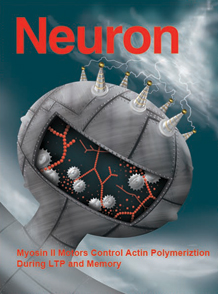

Scripps Research Scientists Uncover New Mechanism of Memory Formation
By Eric Sauter
Scientists from the Florida campus of The Scripps Research Institute have discovered a mechanism that plays a critical role in the formation of long-term memory. The findings shed substantial new light on aspects of how memory is formed, and could lead to novel treatments for memory disorders.
The study was published as the cover story of the journal Neuron on August 26, 2010.
In the study, the scientists found that a main driver of memory formation is myosin II, a motor protein critical to cell movement and growth.
"By showing for the first time that myosin II acts as the principal organizer of memory formation, we are that much closer to identifying the signaling pathways that activate this motor protein in the brain," said Gavin Rumbaugh, an assistant professor in the Department of Neuroscience at Scripps Florida who led the study. "Once we're able to do that, we can begin to develop potential treatments that could restore memory in people who suffer from cognitive disorders like Alzheimer's disease."
In the study, Rumbaugh and his colleagues showed that myosin II mediates a mechanical process that is part of the complex process of memory formation.
Specifically, myosin II links together the initiation of long-term potentiation, a process that enhances signal transmission between two neurons in the creation of memory; the stabilization of synaptic plasticity (the ability of synapses to maintain this enhanced transmission); and the reorganization of neurons' F-actin, a cellular polymer that enables growth of synapses.
"Stimulation in the brain turns on these myosin motors and this triggers the growth of F-actin that ultimately solidifies the enhancement of neuronal communication," Rumbaugh said. "Growth and strengthening of synapses is a process that the brain uses to record our experiences. We are just now beginning to understand the physical substrates within synapses that enable the storage of our life experiences."
He added that the role of F-actin described in the study is consistent with the long-standing idea that long-term potentiation is dependent on changes to the synaptic architecture, suggesting the dynamic reorganization triggered by myosin II represents an early step in information encoding.
"Many parallel brain processes have to be activated to store information," he said. "If any one of them is disrupted, the information doesn't get stabilized and the memory is lost. Myosin II is a central regulator of this process and if you could pharmacologically control myosin II, you could potentially regulate memories at will."
The first author of the study, "Myosin IIB Regulates Actin Dynamics during Synaptic Plasticity and Memory Formation," is Christopher Rex of The University of California, Irvine. Other authors include Cristin F. Gavin and Courtney A. Miller of Scripps Research; Maria Rubio of the University of Alabama, Birmingham; Eniko Kramar, Lulu Y. Chen, Yousheng Jia, Christine Gall and Gary Lynch of University of California, Irvine; Richard Huganir of Johns Hopkins University School of Medicine; and Nicholas Muzyczka of the University of Florida, Gainesville. For more information, see http://www.cell.com/neuron/abstract/S0896-6273(10)00554-4
The work was supported by the University of Alabama, Birmingham; the McKnight Brain Institute; Alabama Health Sciences Foundation; the National Institutes of Health; and the Kauffman Foundation.
Send comments to: mikaono[at]scripps.edu

The study, which was published as the cover story of the journal Neuron, showed that a main driver of memory formation is myosin II, a motor protein critical to cell movement and growth.
